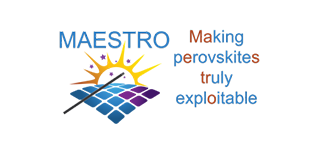Making Perovskites Truly Exploitable

ACRONYM:
MAESTRO
START DATE:
01/12/2017
LATE DATE:
30/04/2022
FUNDING SOURCE:
EU/H2020

ACRONYM:
MAESTRO
START DATE:
01/12/2017
LATE DATE:
30/04/2022
FUNDING SOURCE:
EU/H2020
MAESTRO-H2020-MSCA-ITN-2017 https://maestro-itn.eu
This project has received funding from the European Union’s Horizon 2020 research and innovation programme under the Marie Skłodowska-Curie grant agreement No 764787
The European Training Network MAESTRO (MAking pErovskiteS TRuly explOitable) will generate new skills, knowledge and innovation in the exploitation of perovskite materials in solar power and efficient lighting through establishing exploitation paths for perovskite devices in an integrated unitary approach.
MAESTRO is a coordinated training network, including 10 universities with outstanding track records in perovskite research including the two leaders in this field, five SMEs, a multinational company and the UK national metrology laboratory from 8 EU (2 in the EU-13) and associated countries, giving ESRs exposure to a wide spectrum of expertise: materials synthesis and fabrication, device characterization, and modeling, upscaling and manufacturing. Maestro’s overall objective is to generate new skills, knowledge and innovation in the exploitation of perovskite materials for optoelectronics with a focus on solar power and efficient lighting.
Maestro focusses on perovskites, a material shown in the last 4 years by UOXF and EPFL to have revolutionised solar power1 with the potential to do the same for display technology. These perovskites are semiconductors with a cubo-octahedral crystal structure, are commonly hybrid organicinorganic and include Pb or Sn halides. Perovskite solar cells, PSCs,
offer significant advantages: they are potentially low cost, simple to manufacture and have high power conversion efficiencies, PCEs. Intrinsic properties like tunable broad absorption spectra, fast charge separation, long transport distance of electrons and holes, long carrier separation lifetime, make perovskite solar cells PSCs and photodiodes very promising. Perovskites also show high photo-luminescent quantum efficiencies (PLQEs) so PeLEDs, perovskite LEDs (Figure 1b) have attracted interest for color displays since they, like PSCs, are potentially low cost and easy to make, and colors can be tuned. This exciting emerging technology offers broad skill development and experience of cross sector research.
The research aim is to address barriers to exploitation of this new technology aided by the high level of commercial engagement in the consortium. These barriers are: (a) present high cost (b) short lifetimes under operating conditions (c) difficulties in manufacturing (d) damage done to the environment, encountering regulatory concerns
Maestro’s research aim is to find the means that allow perovskite based devices to be commercially viable. To achieve this aim, Maestro has the following research objectives
(i) to find materials, devices, modules that satisfy the 4 selection criteria:
(a) low cost (high PCEs or PLQEs, costs of materials and fabrication e.g. solvents); (b) durability (industry standard tests); (c) scalability (synthesis and module fabrication); (d) environmental impact (low energy and resource demands, reduced toxicity)
(ii) to expand exploitation possibilities from PSCs by investigating photodiodes and PeLEDs
(iii) to establish manufacturing methods for perovskite modules